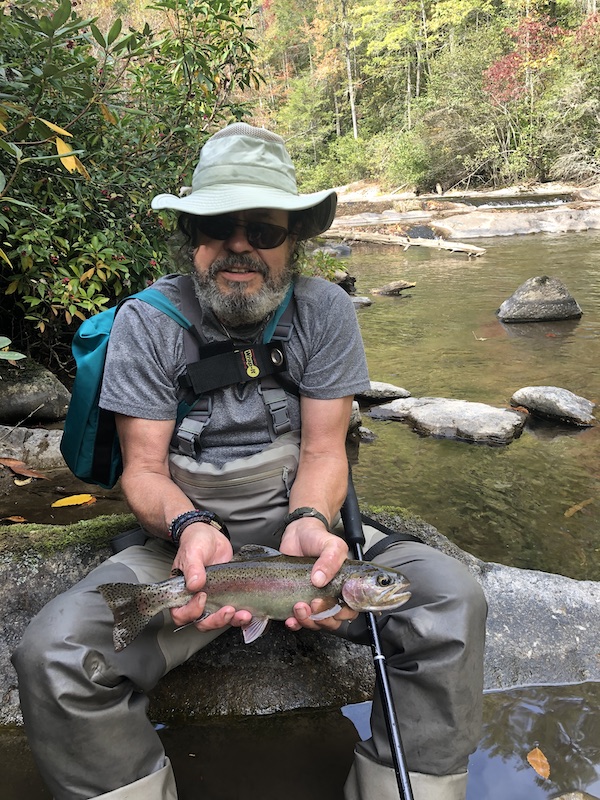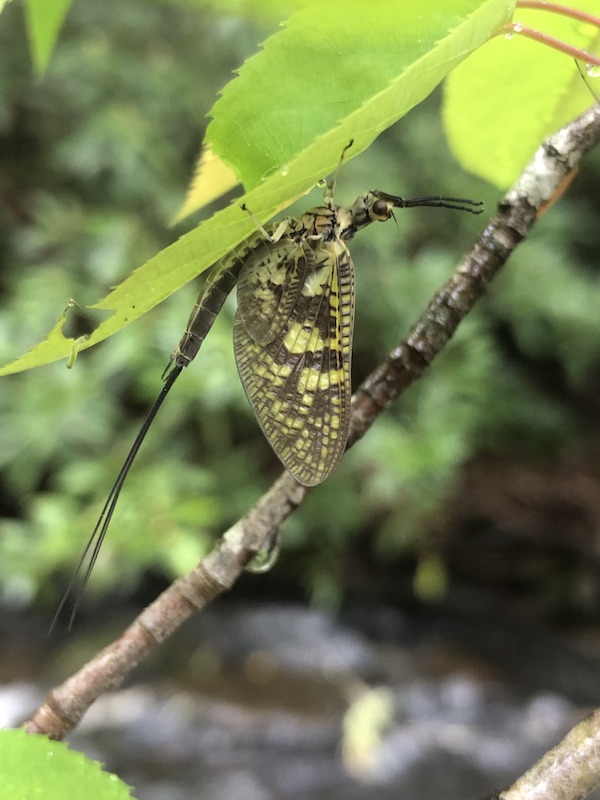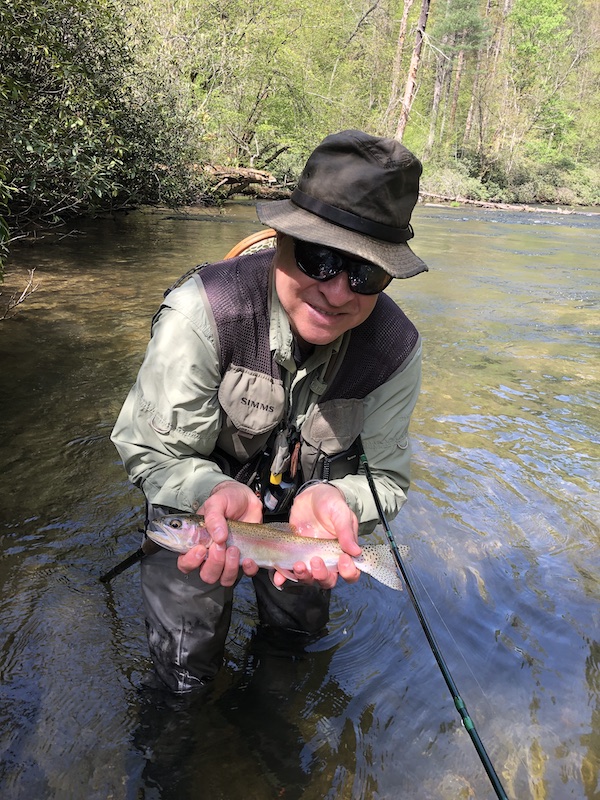Overview of Fly Fishing Abrams Creek
If ever there was a perfect trout stream in the Smokies, it would be Abrams Creek. The resident trout grow quickly from the unusually rich environment compared to most southern Appalachian streams. Due to a strong limestone spring fed influence, the PH is much better in Abrams Creek than other Park streams. This provides the perfect environment for mayflies, caddisflies, stoneflies, and midges to thrive. Fall through spring is our favorite time for fly fishing Abrams Creek. The crowds in Cades Cove are a deciding factor on when to fish this stream.
There are several distinct sections of Abrams Creek. This includes the easier access just below the Abrams Falls trailhead, the spring creek section, headwater tributaries, the backcountry sections along Abrams Falls trail and lower Abrams Creek. The headwater tributaries start on the ridges above Cades Cove including the flanks of famed Gregory Bald, Rich Mountain, and the high ridges of the Smokies between Tennessee and North Carolina. The most important tributaries for anglers include Anthony Creek, Mill Creek, Forge Creek, and Rabbit Creek. However, the quality of Abrams Creek fishing easily overshadows these small tributaries. They should be viewed as interesting alternatives if the main creek is slammed with other anglers and nothing more.
Lower Abrams Creek Fishing
Fly fishing on lower Abrams Creek is all about the warm water opportunities. Lower Abrams Creek has very limited access. Some anglers like to paddle to the mouth of Abrams on Chilhowee Lake and fish upstream from there, while others start at the Abrams Creek Campground. Either way, you have a long roadless section that also doesn’t have any trails between the lake and campground.
Upstream from Abrams Creek Campground, you have decent smallmouth fishing for a ways, but the stream is quickly becoming a trout stream. By the time you reach the mouth of Rabbit Creek, you are well into good trout water. This trout water on the lower section extends all the way up to Abrams Falls. The limiting factor on lower Abrams Creek trout water is access. Very steep banks, lots of deadfall due to tornadoes in 2011 and other high wind events, and notoriously slippery wading makes this section best left to the resident otters.
Fishing the Abrams Creek Horseshoe and Little Horseshoe
The Horseshoe is the stuff of legend. A long stretch of remote backcountry water with only an entry point and an exit point. If you take too much time and don’t make it through before dark, you’ll join many others who have inadvertently spent the night in the Abrams Creek backcountry. These sections in particular should be fished with either a guide or someone else who knows the best way through and how to stay on schedule. Due to the long nature of these fishing days, the Horseshoe and Little Horseshoe fall under our “Backcountry Extravaganza” pricing.

Anglers should be in excellent shape and be prepared for emergencies when fishing the Abrams Creek backcountry. I always carry extra food, water filter, and at least two methods of making fire along with a small emergency blanket. This is not a bad idea on any backcountry stream, but Abrams Creek in particular is super slippery.
The downside to fishing these backcountry Horseshoe sections is the possibility of getting stuck behind another angler. If that happens, backtrack and climb out before getting too committed. Once you are well into the Horseshoe, there is no exit without completing the entire route.
Fishing in this section is about like on all of Abrams Creek. Lots of nymph fishing with the possibility of some excellent dry fly opportunities. We like to fish dry/dropper as much as possible to cover all possibilities, but some of the super deep holes are just begging for a nymph or even a streamer.
Ethics On Backcountry Streams Like Abrams Creek
A word on ethics when fishing Abrams Creek, particularly these backcountry sections. All fish on Abrams Creek are wild. As such, if you choose to harvest a fish, there won’t be more showing up anytime soon. While it is perfectly legal to harvest fish within the guidelines of the National Park fishing regulations, we do have some strong opinions on the subject as catch and release fly fishing guides.
I would particularly urge you to release any fish over 10 or 11 inches in length. These larger fish are the breeding population for this special stream. Without them, fish numbers would quickly suffer. A few selfish anglers every year hammer this stream and keep more of these special fish than anyone can justify. Unfortunately it shows in the fishing with lowered catch rates and decreased quality. A few bad apples can ruin it for everyone. Don’t be those anglers.
Fishing Abrams Creek on Accessible Trailside Sections
While the Horseshoe sections get the most mythical publicity, the trailside sections are as good or nearly so. The fishing pressure is a little higher, but you can almost always find both an open section and willing fish. We usually gravitate towards nymph or dry/dropper rigs, but epic hatches can also bring all the fish to the surface. In those scenarios, we tie on a dry or double dry rig and have fun. In particular, the green drake hatch provides the most incredible opportunities you can imagine.

Large ledge systems make wading tricky, and I highly recommend a wading staff. If water levels are elevated, this is not the stream to be stumbling around on. This is particularly true in some of the most accessible water near the trailhead. Even with the easy access, make sure someone knows where you are going or go with a buddy.

Fishing the Spring Creek
The spring creek section is a favorite with a few local anglers, but is otherwise overlooked. From from above the Cades Cove Loop road down to the confluence with Mill Creek, the Spring Creek stays warm in the winter and cool in the summer. Anglers overlook this section because of the difficulty in fishing this portion of Abrams Creek. Watch out for quick sand, beaver holes in the banks, deadfall, briars, and of course snakes in warmer weather. As a spring creek, this section has many long flat glassy pools which are difficult to fish. The rewards here are found through persistence and no small amount of luck. This is PhD fly fishing and is best for anglers wishing to push their skill set to the limit.
Abrams Creek Tributaries
If you have time to explore, all of the notable tributaries of Abrams Creek are worth fishing. However, don’t expect too much. I view these as alternatives if the main creek is buried in anglers. Anthony Creek in particular is a nice stream if you are visiting with your family. Running between the Cades Cove Picnic Area and Campground, it is a perfect spot for wetting a line while your family is busy with lunch or supper. Chunky little rainbows abound with brook trout further upstream. Anthony Creek eventually goes underground except during periods of very high flows. It, along with all the other streams draining into the top of Cades Cove, reemerges in large springs near the bottom of the Cove as the Spring Creek section of Abrams.
Mill Creek and Forge Creek are neat little mountain streams that you can access near the Mill in Cades Cove and on Forge Creek Road. The main problem on these streams is both summer water temperatures at this low elevation and tight fishing conditions. Still, they both hold at least a few small rainbows and can be fun if you are in the area.
Rabbit Creek is the only significant backcountry tributary on lower Abrams. It has a backcountry campsite close by which makes for a good base to fish this area. As a small stream, it offers numerous small rainbows, but not anything that justifies the effort required to access this portion of the Park. I consider this a stream to check off the list while hiking all the trails in the Park and nothing more.
